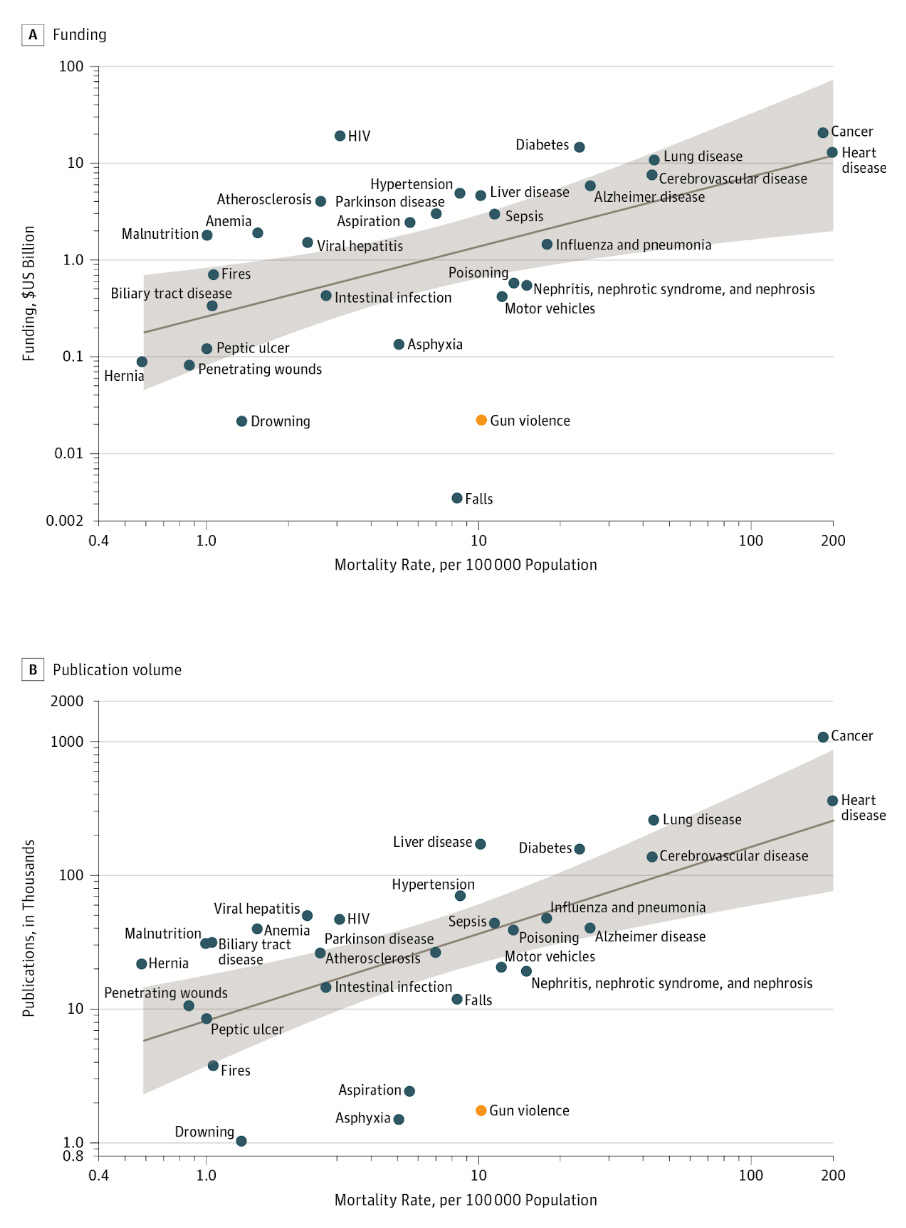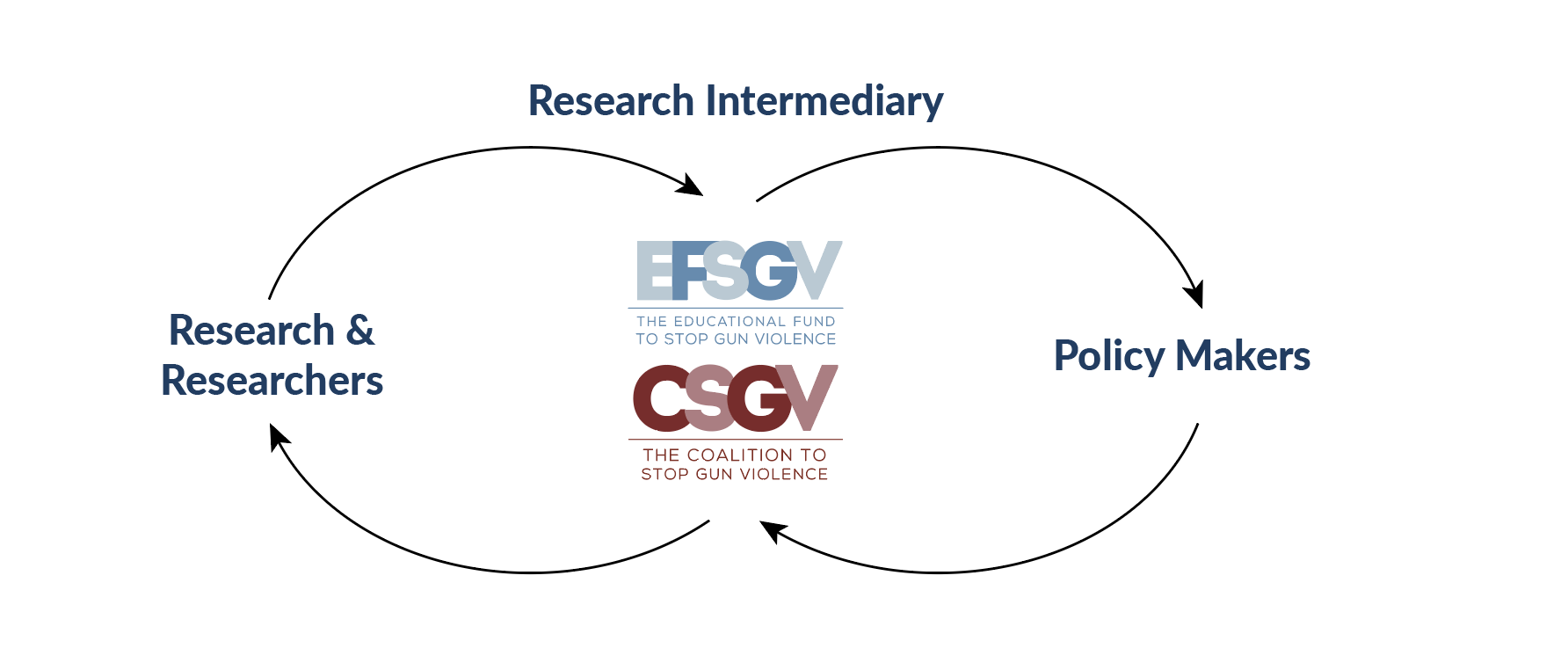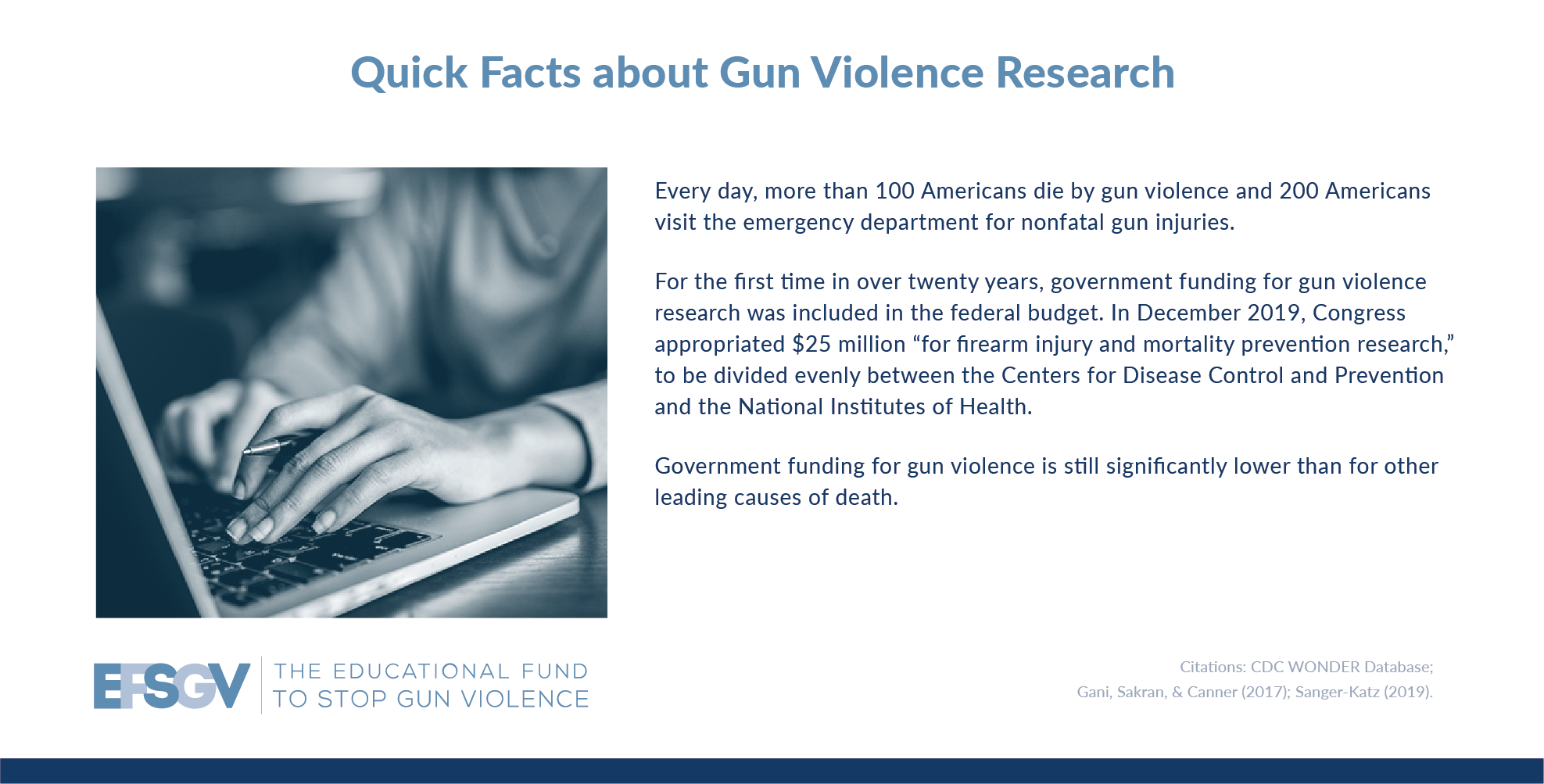Gun Violence Research
Background
On average, more than 37,000 Americans are killed by guns every year. Over the last 10 years (2009-2018), the overall gun death rate increased 18% (from 10.07 to 11.90 gun deaths per 100,000).1 Even while this public health crisis is worsening, very little government funding for gun violence prevention research is available.
One would expect that such a serious threat to public health would be addressed by researching the causes and developing evidence-based solutions, but unfortunately, until December 2019, Congress held gun violence researchers hostage for more than two decades by refusing to dedicate funds for research.
While Congress did finally appropriate funding for gun violence research in December 2019, the amount set aside is not enough to properly study this public health crisis. Even with this funding, we still lack the resources to adequately address the country’s gun violence epidemic. Private foundations and individuals have taken it upon themselves to fund the vast majority of gun violence research in the U.S. While this private research has led to essential policy breakthroughs, there is still a huge deficit without adequate federal funding needed to truly address this public health emergency.
Sepsis kills roughly as many Americans as gun violence, yet government funding to study gun violence is only 0.7% of what is allocated to study sepsis.2 Put yet another way, the government spends only $150 on preventive research for every gun violence death, while nearly $15,000 is spent per death from sepsis.3
While this ratio may change slightly with the newly allocated federal funding for gun violence research, funding for gun violence still dwarfs funding for other leading causes of death.
To learn more, visit our page on gun violence in the United States.
Why do we need gun violence research?
Gun violence is a public health crisis, and we cannot expect to solve this crisis without funds dedicated to study it. On average, more than 37,000 Americans are killed by guns every year, including nearly 23,000 who die by firearm suicide, more than 13,000 who die by firearm homicide, more than 500 who die by legal intervention,4 nearly 500 who die by unintentional firearm injuries, and more than 300 who die by undetermined intent.5 This equates to more than 100 gun deaths every single day. Additionally, each year there are more than 71,000 emergency department visits for nonfatal gun injuries — nearly 200 every day.9 While these nonfatal gun injuries may not make the national news, they leave lasting physical, psychological, and emotional scars.
With public health research, we can help reduce and prevent firearm injuries and deaths and translate research into effective programs and policies. This is not a new concept. Indeed, the public health approach and public health research have been used to reduce motor vehicle deaths, drownings, and fires. We can and must do the same with gun violence, but in order to do so, we need to have the resources.
While foundations and universities have funded some gun violence research, there is still a critical need for more funding. Government training grants to fund doctoral students and postdocs in gun policy research are lacking. As a result, just a few years ago, there were only about 30 dedicated gun violence policy researchers in the U.S.10 By withholding resources to study this public health crisis, we are discouraging new researchers from studying one of the most pressing public health problems we face.
To learn more, visit our page on the public health approach to preventing gun violence.
What do we need to research?
Gun violence is a complex, multifaceted issue. In order to understand the true burden of gun violence and its solutions, we need more research and data on:
- Risk and protective factors for all forms of gun violence — including suicides, domestic violence, community gun violence, youth gun violence, mass shootings, police-involved shootings, and unintentional gun injuries and deaths.
- Fatal and nonfatal firearm injuries, including demographic information of victims and perpetrators, type of firearm(s) used, and surrounding circumstances.
- The flow of illegal firearms and the underground gun market.
- Policies and programs that are effective in reducing gun violence (and also knowing which policies and programs perpetuate gun violence) as well as best practices for equitable implementation.
By better understanding what contributes to gun violence in all its forms, we can be empowered to craft solutions to prevent these injuries and deaths.
Funding Public Health Research
Reliable research is critical to understanding and implementing evidence-based policies and programs to reduce gun violence. For far too long, funding for and research publications on gun violence has been lacking. However, thanks to increasing interest in funding and research, this appears to be changing.
Funding and Research Publication for Gun Violence Versus Other Leading Causes of Death
The graph below, taken from a 2017 Journal of the American Medical Association article, shows that when looking at the 30 leading causes of death in the U.S. by mortality rate and publication volume, it is evident that the U.S. spends less money on research and publishes fewer articles on gun violence than nearly all of the other leading causes of death.

Source: Stark DE & Shah NH. (2017). Funding and publication of research on gun violence and other leading causes of death. Journal of the American Medical Association.
Take, for example, the amount of money spent on preventing motor vehicle deaths and the number of publications on this topic. Every year, over 37,000 Americans die from motor vehicle crashes — almost the same number that die from gun violence.8
The country’s approach to preventing motor vehicle crashes has been starkly different than the approach to preventing gun violence deaths. For example, the Department of Transportation began tracking motor vehicle deaths in the Fatality Analysis Reporting System in 1975.9 Their system records more than 100 variables related to motor vehicle crashes, including information on the crash type, vehicle type, road type, driver characteristics, and passenger characteristics. Since tracking on this public health crisis began, the rate of motor vehicle fatalities has nearly been cut in half. The reduction in motor vehicle crashes in the U.S. is considered one of the greatest public health successes.
Unfortunately, there is no similar national database for gun deaths or injuries that contains that level of detail. To tackle the problem, we must have a clear understanding of the problem itself.
The Dickey Amendment
Over twenty years ago, Congressman Jay Dickey (R-AR) authored an amendment in a 1996 spending bill which mandated that “none of the funds made available for injury prevention and control at the Centers for Disease Control and Prevention may be used to advocate or promote gun control.” This has become colloquially known as the “Dickey Amendment.”10 The amendment also reallocated $2.6 million in CDC funds that had been dedicated for firearm injury research the previous year. While the Dickey Amendment prohibits using CDC funds to advocate for “gun control,” it does not prohibit studying gun violence. However, until recently, Congress hadn’t dedicated money specifically to research gun violence at the Centers for Disease Control and Prevention (CDC) or the National Institutes of Health (NIH) since before the Dickey Amendment was added to the 1996 spending bill.
The result has been a lack of federal funding and a chilling effect on gun violence research for the past two decades. Gun violence, as compared to other leading causes of death, was the second least funded and the least researched cause of death in the U.S. in relation to mortality rates from 2004-2015.11, 12
Indeed, the Dickey Amendment made it so that the CDC was hesitant to study gun violence. Daniel Webster, one of the country’s leading gun violence researchers, summed it up perfectly, writing, “Clearly, at CDC 20 years ago…they got the message that if you fund research that really angers the gun lobby, you risk substantial cuts to your budget.”13
While the Dickey Amendment is problematic, federal funds can and should still be used to research gun violence in the United States. The bigger issue at hand is that, until 2019, Congress had not made specific appropriations for gun violence research.
“When people ask me questions about gun violence and its prevention, there are inevitably questions that I cannot answer because the research needed to answer those questions has not yet been done. Unfortunately, many promising avenues of research into how to reduce nonfatal and fatal shootings have not yet been explored due to lack of funding. I implore Congress to fund gun violence research so we can answer more questions and save more lives.”
- April M. Zeoli, PhD, MPH, Associate Professor, School of Criminal Justice, Michigan State University
Government Funding for Gun Violence Becomes a Reality
For more than two decades, both the CDC and the NIH have been left with a void in their research funding for gun violence prevention. In 2019, the House of Representatives took an important step towards ending this research freeze and passed the first appropriations minibus that included $50 million to support “firearm injury and mortality prevention research” divided evenly between CDC and NIH.
Ultimately, Congress successfully included $25 million, split evenly between the CDC and NIH, to study gun violence in the Fiscal Year 2020 Budget.
Federal Firearms Data Sources
While there are a number of federally government-funded data sources related to firearms, the data is considered “disordered and highly segmented.”16 Indeed, there is no one single data source for information related to firearm deaths and injuries. According to a 2020 National Opinion Research Center (NORC) report, there are 29 federal data sources that include at least some measures related to firearms. However, each data source and database has its limitations, including the fact that there are serious lag times in reporting.
For example, the Federal Bureau of Investigation (FBI) hosts a number of national crime databases, including the FBI Supplementary Homicide Report. While the FBI Supplementary Homicide Report has numerous data variables, including data on the type of weapon used in the homicide, victim and offender age, sex, and race, and the offender’s relationship to the victim, law enforcement reporting is not mandatory.
Additionally, CDC’s National Center for Health Statistics National Vital Statistics System is an important tool for identifying data on gun deaths. However, this data source is not considered a reliable source for unintentional or legal intervention firearm deaths, as the data is considered inaccurate in many states. Further, there is usually a two year lag for reporting this data, making it hard to understand the true burden of gun violence in the United States in real time. In short, there is a critical need for more accurate data and timely reporting on gun violence in the United States.
For more information on government and private data sources related to firearms, see NORC’s “First Report of the Expert Panel on Firearms Data Infrastructure: The State of Firearms Data in 2019.”
Research Persists, Despite Inadequate Funding
Even during the time of lapsed federal funding for gun violence research, and despite robust, accurate, and timely data reporting, research persisted across the country to better understand the burden of gun violence in the United States. Importantly, much of what we know today about the solutions for stopping gun violence is due to the Joyce Foundation. For over 25 years, the Joyce Foundation has funded informative gun violence prevention research. When there was little private or public funding for gun violence prevention research, Joyce filled this void and sustained the field and funded hundreds of scientific publications. To learn more about the Joyce Foundation’s contributions to gun violence prevention research, see their report: 25 Years of Impactful Grant Making: Gun Violence Prevention Research Supported by the Joyce Foundation.
In addition to the Joyce Foundation’s contributions, colleges and universities are home to some of the most reputable gun policy centers. These centers, which are either state-funded or funded by private universities and foundations, continue critical research on gun policy despite barriers in federal funding. In addition, there are privately-funded collaboratives also working to understand and prevent gun violence.
To learn more about the work that these Centers and Collaboratives do, click on the resources below:
- AFFIRM Research
- Center for Gun Violence Reporting
- Consortium for Risk-Based Firearm Policy
- Cure Violence
- Duke Center for Firearms Law
- Firearm Safety Among Children and Teens (FACTS) at the University of Michigan
- Gun Violence Prevention Forum (Northwell Health)
- Harvard Injury Control Research Center
- Healing Justice Alliance
- The Health Alliance for Violence Intervention (HAVI)
- Johns Hopkins Center for Gun Policy and Research (JHCGPR)
- Kaiser Permanente
- National Institute for Criminal Justice Reform
- National Network for Safe Communities
- RAND Corporation
- Regional Gun Violence Research Consortium at the Rockefeller Institute of Government
- University of Chicago Crime Lab
- University of Washington School of Public Health
- University of Virginia’s Youth Violence Project
- Urban Institute: Justice Policy Center
State-funded Research Centers and Offices:
- New Jersey’s Center on Gun Violence Research (Center) at Rutgers
- Office of Firearm Safety and Violence Prevention (Washington)
- University of California Firearm Violence Research Center (UCFC)
In addition, there are many researchers working throughout the country that conduct research on gun violence and contribute to the field without the support or backdrop of a gun violence research center. Significant progress has been made because of these researchers.
Spotlight on the University of California Firearm Violence Research Center (UCFC)
California is one of just a few states that fund gun violence research. The Firearm Violence Research Center, led by Dr. Garen Wintemute at UC Davis, was established in 2017 and is the first state-funded gun violence prevention research center in the country.17
According to the California Firearm Violence Research Act,18 “UCFC will conduct interdisciplinary work to address:
- The nature of firearm violence, including individual and societal determinants of risk for involvement in firearm violence, whether as a victim or a perpetrator.
- The individual, community, and societal consequences of firearm violence.
- Prevention and treatment of firearm violence at the individual, community, and societal levels.”
Consortium for Risk-Based Firearm Policy
The Consortium for Risk-Based Firearm Policy (Consortium), which was co-founded and is staffed by the Educational Fund to Stop Gun Violence, includes the nation’s leading researchers, practitioners, and advocates in gun violence prevention, public health, law, and mental health. In the spring following the horrific shooting in Newtown, Connecticut in December 2012, members of the Consortium convened for the first time to discuss research evidence and identify areas of consensus regarding risk factors for future violence. This initial meeting resulted in a commitment to advance evidence-based gun violence prevention policy recommendations through the newly formed Consortium.
Policymakers on the federal and state level have relied on the Consortium’s recommendations to craft legislation and executive action which continue to shape the policy landscape of the gun violence prevention movement.
To learn more, visit our page on the Consortium for Risk-Based Firearm Policy.
“For far too long, legislators have held gun violence researchers hostage by refusing to appropriate dedicated funds for gun violence research. As gun deaths have climbed, researchers and scientists have been limited in their efforts to research solutions to reduce American gun fatalities and injuries. It is time for Leader McConnell to take action and fund gun violence prevention research to help solve this uniquely American epidemic.”
- Dakota Jablon, Director of Federal Affairs
Research Translation
Research translation bridges the gap between research, researchers, and policymakers. The Educational Fund to Stop Gun Violence acts as a research intermediary by translating the research into effective advocacy for evidence-based policies and programs.
In order to do this, our team synthesizes and applies existing research and the best available scientific evidence to develop gun violence prevention policy recommendations to address gun violence. We inform relevant stakeholders of these policy recommendations by developing educational materials, including reports and issue briefs, conducting public forums, and submitting expert testimony.
Effective translation of research is key to disseminating policy recommendations to legislators and other important stakeholders. In addition, elevating the voices of researchers and health professionals is critical to ensuring public health policies are designed, discussed, and considered based on research and evidence. Our organization provides staff support to the Consortium for Risk-Based Firearm Policy, effectively acting as a research intermediary between researchers and policy makers.

To learn more about the Ed Fund’s role as a research intermediary, read McGinty EE, Siddiqi S, Linden S, Horwitz J, & Frattaroli S. (2019). Improving the use of evidence in public health policy development, enactment and implementation: a multiple-case study. Health Education Research.
Recommendations
Fund and conduct gun violence research, which is fundamental for effective gun violence prevention.
Public health is the science of reducing and preventing injury, disease, and death and promoting the health and well-being of populations through the use of data, research, and effective policies and practices. Research is the first step in the public health approach for gun violence prevention and increases understanding of the root causes, risk factors, and solutions to gun violence. These research findings can then be translated into effective interventions, whether through policy or practice. Solid data, scientific research, and funding to support such research are critical for effective gun violence prevention. We recommend:
- Better data collection: Federal, state, and local governments should collect more comprehensive gun violence data for fatal and non-fatal firearm injuries, shootings that may not involve physical injuries, police-involved shootings, and firearm-involved crimes where no shots were fired, including domestic violence-related threats. Federal, state, and local governments should make data publicly available where possible and particularly to researchers studying gun violence and its prevention.
- Conduct scientific research: Universities and other research institutions should conduct robust research on the root causes, risk factors, and solutions to gun violence in all its forms and support education and training of students in gun violence research.
- Research translation: Research should be translated and applied to ensure that gun violence prevention policies and practices are evidence-based.
- Development, implementation, and evaluation: Gun violence prevention policies and practices should be developed based on research and should be continuously monitored and evaluated to ensure equitable implementation and ongoing effectiveness. These findings then contribute to the body of evidence upon which new interventions are developed.
- Research funding: Enhanced research funding is key for advancing knowledge and improving public health interventions and outcomes. Congress should provide dedicated funding for the CDC, NIH, NIJ, and other government agencies to study gun violence prevention, while state governments should establish and fund interdisciplinary research centers dedicated to gun violence research. Foundations have long been the backbone of gun violence research; their continued support is fundamental to gun violence prevention.
Resources
Educational Materials
Fact sheets
Reports
- Consortium for Risk-Based Firearm Policy: Breaking Through Barriers: The Emerging Role of Healthcare Provider Training Programs in Firearm Suicide Prevention
- Consortium for Risk-Based Firearm Policy: Firearms Removal/Retrieval in Cases of Domestic Violence
- Consortium for Risk-Based Firearm Policy: Guns, Public Health, and Mental Illness: An Evidence-Based Approach for State Policy
- Consortium for Risk-Based Firearm Policy: Guns, Public Health, and Mental Illness: An Evidence-Based Approach for Federal Policy
Read More
- June 2019 op-ed in The Hill, Congress must vote to fund gun violence research
Research
- Cone J, Williams B, Hampton D, Prakash P, Bendix P, Wilson K, et al. (2019). The ethics and politics of gun violence research. Journal of Laparoendoscopic & Advanced Surgical Techniques.
- Cunningham RM, Ranney ML, Goldstick JE, Kamat SV, Roche JS, & Carter PM. (2019). Federal funding for research on the leading causes of death among children and adolescents. Health Affairs.
- Denne, SC, Baumberger J, & Mariani M. (2020). Funding for gun violence research: the importance of sustained advocacy by academic pediatricians. Pediatric Research.
- Galea S, Branas CC, Flescher A, Formica MK, Hennig N, Liller KD, et al. (2018). Priorities in recovering from a lost generation of firearms research. American Journal of Public Health.
- Jaffe S. (2020). Decisions to be made on US gun violence research funds. The Lancet.
- Jaffe S. (2018). Gun violence research in the USA: the CDC's impasse. The Lancet.
- McGinty EE, Siddiqi S, Linden S, Horwitz J, & Frattaroli S. (2019). Improving the use of evidence in public health policy development, enactment and implementation: A multiple-case study. Health Education Research.
- Stark DE & Shah NH. (2017). Funding and publication of research on gun violence and other leading causes of death. Journal of the American Medical Association.
Additional Resources
- Greenfieldboyce N. (2019). How The CDC's Reluctance To Use The 'F-Word' — Firearms — Hinders Suicide Prevention. NPR.
- Hauck G, Ellis NT, & Filby M. (2020). Congress Approved $25M in Funding for Gun Safety Research. Now What? USA Today.
- Koerth M. Congress Is Throwing A Little Money At Gun Violence Research. It Might Go A Long Way. FiveThirtyEight.
- Laslo M. (2019). The CDC Could Totally Study Gun Violence—It Just Needs Money. WIRED.
- Sanger-Katz M. (2019). Gun Research is Suddenly Hot. New York Times.
- Schumaker E. (2019). Gun Violence Researchers Find Their Field at a Crossroads. The Trace.
- Turnbell L. (2019). Gun Violence Research Matters. Here’s Why. Yes Magazine.
- Van Brocklin E. (2019). States Are Funding the Gun Violence Research the Feds Won’t. The Trace.
- Wan W. (2019). Congressional Deal Could Fund Gun Violence Research for First Time since 1990s. Washington Post.
- Wexler L. (2017). Gun Shy. Johns Hopkins Bloomberg School of Public Health Magazine.
Last updated July 2020

